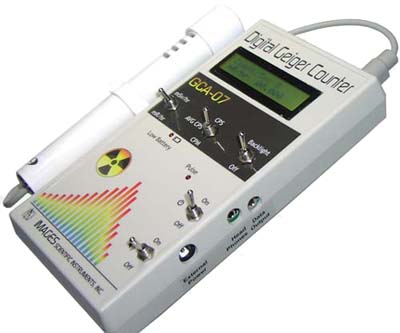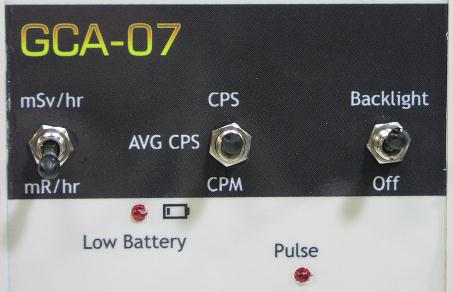Introduction to the Geiger Counter
Throughout these experiments I will be using a digital GCA-07W Geiger counter from Images SI Inc. to conduct our experiments.
To understand the differences in Geiger counters please read the chapter titled “How to Purchase a Geiger Counter.”
What is radiation?
Before we use our Geiger counter to detect and measure radiation, we need to define what we mean by radiation.
Electromagnetic radiation includes long radio wave to ultra-short gamma rays. In this broad view radiation can include the heat given off from a candle, light emitted by an LED or from particles emitted by uranium ore. To narrow our definition of radiation for the purposes here we are confining it to what is considered ionizing radiation. Ionizing radiation is radiation that can strip electrons from atoms or molecules thereby making the resulting atom or molecule an ion.
Ionization radiation that we will be measuring and performing experiments with are gamma rays, x-rays, beta and alpha particles.

Gamma and x-rays are ultrashort electromagnetic radiation. They have great penetrating power and can easily pass through the body and are attenuated by dense materials such as lead. X-rays penetrating power is commonly used in medicine to take internal x-ray photographs of the human body.
Beta particles are electrons, identical to the electrons found in atoms. Beta particles have a net negative charge. They have low penetrating power. Most beta radiation can be blocked by 1/8” (4mm) of aluminum.
Alpha particles are massive particles consisting of two neutrons and two protons. Alpha particles have a net positive charge. They are equivalent to the nucleus of a helium atom. Alpha particles have a low penetration power. A few inches of air or a piece of paper can effective block alpha particles. The outer skin of our body protects us from alpha particles. Surprisingly, if an alpha particle emitter is ingested or inhaled the alpha radiation is dangerous. Because alpha particles are massive, they have a lot of kinetic energy. When it strikes inside our body it can damage DNA, break chemical bonds and create tissue damage. So, while its penetration is low, the local damage is considerable.
Detecting Radioactivity
There are many instruments available for detecting and measuring radioactivity. We are focused on using the Geiger counter for our detection and experiments.
Geiger Counters are instruments that can detect and measure radioactivity using a Geiger Mueller tube. Geiger Mueller tubes are commonly referred to as a GM tube tube. The original design of the g-m tube by Hans Geiger and E.W. Mueller in 1928 hasn't changed much and the tube's sensor function remains the same.

Radiation, as it passes through the GM tube, ionizes the gas within the tube. The ionization initiates a momentary avalanche of electrons accelerate by the high voltage potential used to power the GM tube. This avalanche, create a momentary conductive path between the wire at the center of the tube (Anode) and the wall of the tube (Cathode), see figure 1 resulting in a 'click' sound. By measuring the number of the clicks, the instrument indicates the radiation levels.
The GM tube sensor is the heart of the Geiger counter and to be a Geiger counter, the device has to contain a Geiger-Muller (GM) tube. The GM Tube can detect gamma and X-ray radiation, beta particles and if equipped with a thin mica window, alpha particles as well.
The model GCA-07 has an internal Geiger Mueller tube. The model GCA-07W uses an external wand that houses the Geiger Mueller tube.Scientific Instrument & Industrial Tool
Our Digital Geiger counters have been calibrated and certified accurate in reading radiation levels to within 5% from background radiation to 1000 mR/hr. NRC Certification available at additional cost.Perfect for schools and industry. In the laboratory the Digital Geiger Counter may be used to conduct nuclear experiments and measurements. Free Windows 7 graphing programs. Graphic Files may be exported to Excel spreadsheets.
Communication specifications are provided for users to read the output of the Geiger Counter and write their own programs.
Applications
* Education - Classroom demonstrations and experiments
* Emergency Services and Domestic Preparedness
* HAZMAT and Compliance Verification
* Dirty Bomb Screening and EMT's

Features
Radiation Detected
Alpha, Beta, Gamma and X-Rays.
Detector
Geiger-Muller tube Ne + Halogen filled with a .38" effective diameter 1.5-2.0 mg/cm2 mica end window.
Detector Sensitivity
· Alpha above 3.0 MeV
· Beta above 50 KeV
· Gamma above 7 KeV
Countable Pulse Range 1 (CPM) - 10000 + counts per second (CPS)
Converted Radiation Range .05 mR/hr - 1000 mR/hr (Imperial)
.0005 mSv/hr - 10.0 mSv/hr (SI Metric)
The Liquid Crystal Display (LCD) is 16 character by 2 line that provides an easy to read output, see image to right. LCD has an on-off backlight switch . LCD display continuously updates counts per second (or counts per minute) on line one while displaying converted radiation level second line.
Backlight Switch turns on and off the LCD backlight,.
The LED marked Low Battery will turn on when the battery power drops to approximately 7 Volts to alert the user to change battery. Readings taken when low battery indicator is on may not be accurate.
The LED marked Pulse—is a secondary radioactive particle indicator it blinks each time a radioactive particle is detected by the Geiger Counter.
The Power Switch turns power on or off to the GCA-07.
The Speaker Switch turns the sound on or off to the internal speaker. The speaker is a secondary radioactive particle indicator. It clicks each time a radioactive particle is detected. Note: Plugging a headphone in the headphone jack will automatically turn off the internal speaker.
Headphone jack is a standard 3.5mm for private listening. Using a headphone automatically turns off the internal speaker of the Geiger counter.
External power jack is available for extended readings where battery operation may not be practical. Power jack is 2.5mm x 5.5mm. Power input is 9VDC or 9VAC @ 200mA min. current. Mobile operation uses a 9V battery.
TTL Serial output for PC available via 3.5MM stereo connector. Both the GCA-07 and GCA-07W output the counts per second.
Main Panel Controls
The first panel switch starting from the left selects whether the radiation levels are shown in Systems International (SI) metric (mSv/hr) or imperial (mR/hr) measurements.


CPS (Counts Per Second) is a one second counting mode. Real time radiation readings and displays the count/second and equivalent radiation level in either mR/hr or mSv/hr.

AVG CPS is a three second average of the CPS. AVG CPS performs a smoothing function similar to analog meter readings. It displays the 3 Second CPS and equivalent radiation level in either mR/hr or mSv/hr.
CPM (Counts Per Minute) is a one-minute counting mode for measuring low levels of radioactivity and background radiation: Displays accumulated count and equivalent background radiation in either uR/hr or uSv/hr. If radiation level is significant, radiation scale level changes and is displayed either mR/hr or mSv/hr.

The first line of the LCD display shows the accumulated time in seconds. The timer starts at 0 seconds and counts to 60 seconds (one minute). When it reaches 60 seconds, it pauses one second then resets. Next to the elapsed time is the accumulated count of radioactive particles detected. The timer continues to count radioactive detections until a full minute (60 seconds) has passed. At the point the display pauses for one-second to show the complete count for the minute and its relative radiation level before resetting the timer and accumulated count to zero and starting to count radioactive particle detections for the next minute, CPM measurement.
The second line on the LCD will continue to show radiation level until it updates again at the end of the minute.
One can also switch from Imperial measurement uR/hr to metric measurement uSv/hr in CPM mode. Updates in imperial/metric mode initiate at the end of the current CPM measurement, when the timer and accumulated count resets.
2. Operations
Survey Meter Modes
CPS Mode: Set the Conversion switch to mR/hr (milliroentgen/hour). The time function switch to “CPS”, Backlight switch on and the audio switch on. Turn on the Geiger counter. If you have a radioactive source bring the source close to the GM tube. For Geiger counters with an external wand, bring the wand close to the radioactive source.

Every radioactive particle detected will cause the Geiger counter to click and the LED to blink.
The LCD digital display in this mode updates the count and radiation level every second, see photo above. The display always shows the previous seconds count and radiation level. The count “Count/Sec.” is the number of radioactive particles detected in the previous second. On the second line the equivalent radiation level of that count in mR/hr. You can change the Conversion switch to mSv/hr to read the radiation level in milli-sieverts/hour.
3-Second Average: The three second average of the CPS. AVG CPS performs a smoothing function similar to analog meter readings. Displays the 3 Second CPS and equivalent radiation level in either mR/hr or mSv/hr.

CPM mode: Displays the counts per minute and convert the radiation level into micro-Roentgens (uR/hr) or micro-Sieverts (uSv/hr). The CPM modes is useful for checking background radiation. First set the switch to Metric or Imperial measurement. Next set the time function switch to CPM. The LCD display changes. The left side of the first line begins a count starting at 1 and increments by 1 up to 60 seconds.

Free Windows PC Geiger Graphing Software
So far, you needed to record CPM numbers manually. However there is an easier way. Images SI Inc. offers free download for their windows PC Geiger Graphing software (https://imagesco.com/geiger/geiger-graph.html). This software will chart and record an unlimited number of readings. So, you could take an hour or more CPM background readings and save the readings to your hard drive.
To connect the digital Geiger counter to the PC requires a compatible 3.5mm TTL to USB cable.

This software allows you to graph radioactivity in a number of different time scales. The data collected on the graph can be saved, and converted to a CSV format that can then be imported in Excel for further analysis and graphing.

The time scale shown below is in CPM and shows the background radiation for sixty CPM reading.




